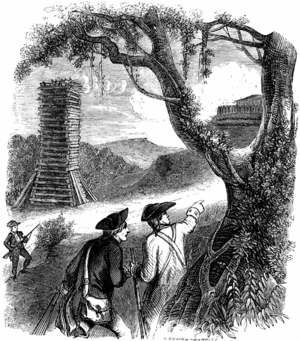Siege of Fort Watson facts for kids
Quick facts for kids Siege of Fort Watson |
|||||||
|---|---|---|---|---|---|---|---|
| Part of the American Revolutionary War | |||||||
 19th-century engraving depicting the siege tower |
|||||||
|
|||||||
| Belligerents | |||||||
| Commanders and leaders | |||||||
| Strength | |||||||
| 80 regulars 40 militia |
300 regulars 80 militia |
||||||
| Casualties and losses | |||||||
| 120 captured | 2 killed 6 wounded |
||||||
The siege of Fort Watson was an important event during the American Revolutionary War. It happened in South Carolina from April 15 to April 23, 1781. American forces, led by Henry "Light Horse Harry" Lee and Francis Marion, surrounded Fort Watson. This fort was a British outpost. It was a key part of their supply route between Charleston and other British bases.
The American attackers did not have artillery (big cannons). This made it hard to break through the fort's strong walls. They also tried to cut off the fort's water supply, but that didn't work. So, they came up with a clever plan. They built a tall wooden tower. From this tower, sharpshooters could fire down into the fort. On April 23, the Americans attacked again. The British soldiers could not stay on the walls because of the constant gunfire from the tower. They soon gave up, and the Americans won.
Contents
Why Fort Watson Was Important
The American Revolutionary War was a fight for independence. Great Britain had a plan to win the war in the southern states. After a battle in March 1781, the British General Lord Cornwallis had won. But his army was low on supplies and had lost many soldiers. So, he moved to Wilmington, North Carolina to get more supplies.
The American General Nathanael Greene had lost that battle, but his army was still strong. He decided to move south. His goal was to take back control of South Carolina and Georgia. In these states, British and Loyalist forces were spread out. This made their smaller bases easy targets for Greene's army or local American militia.
Greene first sent Colonel Henry "Light Horse Harry" Lee to watch Cornwallis. Once Greene was moving into South Carolina, he told Lee to leave Cornwallis. Lee was to join forces with Colonel Francis Marion. Marion was a famous militia leader in eastern South Carolina. Lee and Marion met on April 14. Their first target was Fort Watson. It was a small fort made of wooden walls, located near the Santee River.
The Attack Begins
Lieutenant James McKay was in charge of Fort Watson. He had about 120 men. The fort's main commander, John Watson, was away. He had gone to see Lord Rawdon at Camden.
When Marion and Lee first arrived on April 16, they wanted to cut off the fort's water. There wasn't much cover near the fort for a direct attack. They successfully blocked access to the nearby lake. But the soldiers inside the fort simply dug a well. This ruined the American plan to make them thirsty.
The Clever Tower Idea
One of General Marion's officers, Major Hezikiah Maham, had a new idea. He suggested building a tall tower out of green pine logs. This tower would be strong and thick enough to protect American sharpshooters. From the top of the tower, they could shoot down into the fort.
The Americans spent several days building the tower away from the fort. It was about 30 feet (9 meters) tall. On the night of April 22, they moved the tower close enough to the fort. The next day, April 23, the Americans attacked. Riflemen in the tower fired into the fort. This forced the British defenders off the walls. At the same time, two small groups of American soldiers bravely attacked the walls. They managed to climb over them. The British soldiers inside the fort had no choice but to surrender soon after.
What Happened Next
This victory was important. It broke one of the British supply lines between Charleston and Camden. After the fort fell, Lee and Marion went after John Watson. Lord Rawdon had given Watson 500 men. Watson's job was to chase Marion. But when Rawdon learned that Lee had joined Marion, the situation changed.
General Greene was heading towards Camden. He wanted to stop Watson from rejoining Rawdon before he got there. Lee and Marion succeeded in this. Rawdon was worried about his supplies. He fought Greene at the Battle of Hobkirk's Hill north of Camden without Watson's men. Rawdon won that battle, but he later had to retreat to Charleston.
Lasting Impact
The "Maham Tower" was a great success. This clever idea was used in other battles later on. A famous example is the Siege of Ninety-Six the next month.
The place where Fort Watson stood is now a historic site. It is also the site of an ancient Santee Indian burial mound. It was added to the National Register of Historic Places in 1969. You can find it in Clarendon County, South Carolina.
See also
 In Spanish: Asedio de Fort Watson para niños
In Spanish: Asedio de Fort Watson para niños

